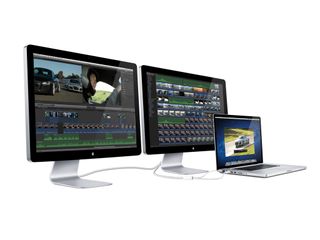The case for an Apple Thunderbolt 2 Display

We all have our big and little wishes for WWDC 2014 next week. The grand unveiling of OS X 10.10 is a forgone conclusion, and we're seeing pundits and analysts chime in on what they expect to see. Our own Rene Ritchie offered his thoughts this morning on what he'd like to see regarding iOS 8. For my part, among the hardware hopes that I have is a replacement for Apple's aged Thunderbolt Display.
Apple doesn't sell a lot of Thunderbolt Displays. At least that's my experience working for a third-party reseller for the past year. But people who buy them are usually outfitting Mac Pros or other high-end, murdered-out Mac workstations built around a loaded up 15-inch Retina MacBook Pro or even a 27-inch iMac. And most people who get them love them. They're excellent monitors.
At $999, Apple Thunderbolt Displays are expensive - the very high end of the 27-inch display spectrum — but they're well-calibrated, easy to work with and they integrate well into a Mac workstation. The display offers three USB ports, a FireWire 800 port, Gigabit Ethernet and a Thunderbolt port, making it an expansion interface of its own for a companion MacBook connected with a single, thin Thunderbolt cable. A nice way to reduce clutter and wear and tear on the connectors of your laptop, to be sure.
The very design of the current Thunderbolt Display is showing its age, however. It came out in July of 2011m, and it closely resembles the iMac of that year, enough so that my customers regularly confuse it with an iMac. But upon closer inspection it's clear that it's not an iMac. It's too thick to be an iMac.
But in 2012, Apple redesigned the iMac. One of the things they did was make the iMac a lot thinner. The Thunderbolt Display still has a thick bezel around the edge, the chunkier design more reminiscent of iMacs that still have internal CD/DVD drives. If you stay up to date on Apple's design trends, the Thunderbolt Display just looks older.
Next, let's look at the expansion options: Three USB ports. Correction — three USB 2.0 ports. USB 3.0 is now standard across the Mac product line, and is practically ubiquitous now when you're shopping for an external hard drive. USB 3.0 is up to ten times faster (on paper, anyway) — it definitely makes a difference for some applications, like cheap external storage.
FireWire 800 and Gigabit Ethernet come in handy if you have a legacy device you need to connect or want to hardware your workstation to a Local Area Network (LAN). But let's look at the Thunderbolt port.
Master your iPhone in minutes
iMore offers spot-on advice and guidance from our team of experts, with decades of Apple device experience to lean on. Learn more with iMore!
The current Thunderbolt Display uses the original Thunderbolt interface instead of the twice-as-fast Thunderbolt 2. Thunderbolt 2 is now standard issue on the Mac Pro and the 15-inch Retina MacBook Pro, two systems primed for use with the Thunderbolt Display. Presumably Thunderbolt 2 will be adopted across the rest of the product line before too long.
For laptop users, the Thunderbolt Display even offers a MagSafe power charger, so you can top up your MacBook Air or MacBook Pro without having to haul out an additional AC charger. But the Thunderbolt Display sports the original MagSafe adapter, instead of the MagSafe 2 interface that all the newer Mac laptops now sport. Apple includes a MagSafe 2 adapter in the box, to bridge the connection to newer laptops. But it's one more thing to misplace on your desk.
2560 x 1440 resolution in a 27-inch screen is enough for me to get lost in. Heck, sometimes I have to jiggle around the cursor just so I can get my bearings, it's so big. That's one reason I'm not convinced that Apple has to go 4K with the next Thunderbolt Display. Another is because 4K support is still relatively limited across the Mac line. Mac users who need it can opt for a third-party DisplayPort-equipped monitor that better meets their needs.
Will we see a new Thunderbolt Display next week? I have no idea. Looking at Apple's release schedule, five of the past nine Apple-branded displays were released in the summer, though of those, not all appeared at WWDCs.
Still, I'll keep my fingers crossed. I'd love to see a shiny new Thunderbolt Display show up on stage next week.
How about you? Any interested in a Thunderbolt 2 Display? Or is it silly for Apple to keep making external displays at all? Sound off in the comments — I can't wait to read what you have to say.
